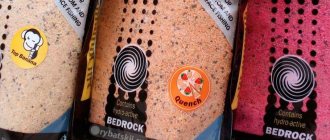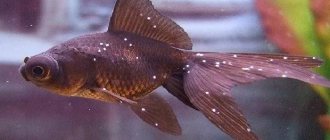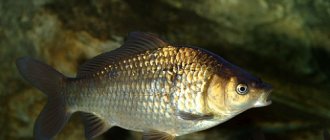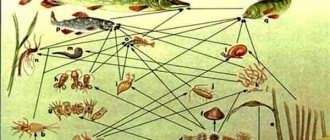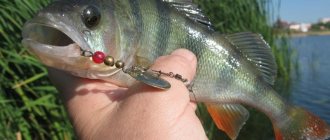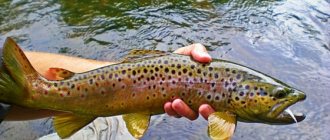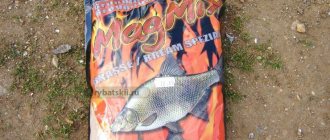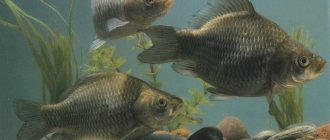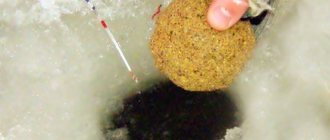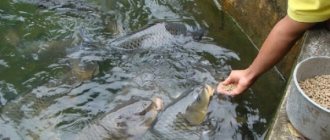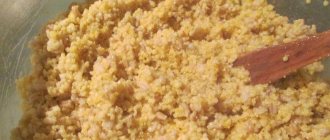Feed composition
Fish feed for carp is created for feeding fish in private reservoirs of pond farms; they contain balanced components that have a beneficial effect on representatives of the ichthyofauna. During their production, vitamins and microelements are strictly dosed.
The compositions may be different, but they are all based on two basics:
- ground crackers,
- bran of cereal crops.
One of the most important components of feed is protein; it comes into mixtures in the form of soybean or sunflower cakes. Moreover, the first option is preferable, since sunflower pomace does not last long due to the high oil content, which, as is known, can quickly go rancid.
In total, the combined fish feed can contain up to forty components, including:
- grains of various fractions,
- legumes,
- cakes,
- meal,
- mineral elements,
- sapropel,
- animal components: daphnia, fish meal, ground shells.
Most often, compound feed is produced in cylindrical granules, the color of which depends on the components used in its composition.
According to the chemical composition, fish feed should contain the following substances:
- proteins, the amino acids of which have a positive effect on the growth, especially of young animals,
- fats that act as a source of energy for fish,
- carbohydrates in the form of plant fiber for nutritional balance,
- minerals and vitamins for the completeness of the feed composition,
- enzymes and premixes as biologically active substances that help in the absorption of food.
The mechanical component of combined feeds is also important so that they are completely consumed by the fish without leaving residues clogging the reservoir. Therefore, the following requirements must be met:
- the strength of the feed granules,
- time-controlled solubility,
- balanced nutritional properties.
Attention! It is on the basis of conventional feed that bait is created, which works best in the reservoirs of pond farms when fishing for carp fish: grass carp, carp, crucian carp, bream and silver carp.
For fishing on a platform, the main thing is to choose the right feed composition.
What to Avoid in Aquarium Fish Food
- Wheat flour. It is a source of carbohydrates, but is not very good for aquarium fish.
- Soy flour. Contains a lot of protein, carbohydrates and phyto-estrogens. It is used quite widely, but there are also sources of protein that are more suitable for fish. There is nothing terrible about soy flour, but it is better to avoid it as part of aquarium food.
- Wheat gluten. It is used as a binding filler and there is nothing more to say about it. Avoid.
- Potato protein. Contains a large amount of carbohydrates.
- Sorbitol. It is made from corn syrup and contains a very high amount of carbohydrates.
- Inositol. Contains too many carbohydrates.
However, not only these ingredients can be useful for fish food. There are also vitamins and minerals that are artificially added to the food, but this is a topic for a continuation that will follow in the coming days.
DRY FOOD VIDEO
Principles of feeding fish in ponds
In order to get used to feeding fish when catching them, you should understand how they feed in pond farms. First of all, we should once again say about the quality of the feed. In addition to the fact that it must be fresh, they monitor its factionalism.
During storage and transportation, partial crushing of the granules occurs. Therefore, before feeding the feed into the reservoir, it is sifted, separating fine particles. They are either returned for processing or fed to poultry: ducks, chickens, etc.
Granules are delivered to the water either by stationary cone-type feeders, or by using the same mobile installations. The latter option is used if the reservoir is of sufficient length.
Attention! In small farms, feeding is often done by simply pouring feed from a boat.
The crumbly feed obtained in the form of a dry mixture is pre-mixed with water to obtain a dough-like mass. Further application is carried out both manually and using feed dispensers.
A simple bunker feed dispenser is easily installed on poles dug into the bottom of the reservoir.
The next important point that fishermen who come to the “pay site” should take into account is feeding time. Usually the fish are fed in the morning, and the schedule is observed daily.
The unity of time and place of feeding allows for more rational use of feed and accustoming fish to regular feeding, which leads, on the one hand, to waste-free production, and on the other, to good fattening for each individual.
Another aspect of fish feeding on farms is control over food consumption. To do this, a couple of hours after unloading food into the water, places on the bottom are examined using nets, scooping up leftover food from the bottom. Based on their number, the bookmark is adjusted for the next day.
Important! The compositions and quantities of feed are regulated depending on the number of fish, its species composition and the age of the individuals!
Feeding carp with grain
They feed him only crushed wheat. The rule that is followed here is that the smaller the size of the fish, the smaller the grain fraction. Adhere to the following instructions:
- 500 gram carp and larger ones are suitable for grains measuring 8 mm;
- individuals whose weight reaches 150-500 g - 6 mm;
- for representatives weighing 40-150 g, it is enough to crush the grain to 4.5 mm;
- small fish weighing 10-40 g require a size of 3.3 mm.
Additionally, read here about the intricacies of carp breeding at home.
This type of fish likes raw grain, but it is better to pre-process it, which improves their taste, since at high temperatures some of the starch is broken down into sugars.
To do this, the grain is poured in a layer of no more than 1 m into a suitable container and filled with hot water (90°C). Stir, cover and leave for 4 hours.
It is better to germinate wheat rather than heat it. In this form, carp eat the grain almost completely. The main thing is not to overexpose it, it is enough for the sprout to reach a length of 2-4 mm.
From an economic point of view, it is more profitable to purchase industrial feed. It costs less than grain, does not require pre-treatment and gives greater growth. However, in nutritional value it is still inferior to natural food of plant and animal origin.
It is recommended to alternate feeding - industrial food with grain. As a treat, carp are given a white loaf, which they eat with great pleasure. To prevent pieces of bread from “furrowing” over the entire surface of the reservoir, it is placed in feeders made from a plastic pipe.
The breeder will tell and show you what he feeds his fish in his home pond in the video below:
Preparation of bait
Depending on what type of feed you have, the method of feeding the fish with it also changes. In the case of granules, you can do it in several different ways; which one is better to choose depends on the fishing conditions:
- Adding granules to water in dry form is used in the case of long-term fishing, when people come to a reservoir for several days.
- For short-term fishing, it is better to pre-soak or steam the granules or mixtures so that by the time they are added to the water, the bait from the mixed feed has a dough-like mass.
- To attract fish to your fishing point, aromatic additives are added to the prepared mass, the composition of which varies according to the season: spicy and meaty in cold water, sweet and fruity in warm water.
- Compound feed can be included in bait as not the main, but an additional component. At the same time, it is mixed with ground seeds, breadcrumbs or a purchased mixture.
Bait made from pre-crushed feed with boiled pearl barley will attract not only carp on the “platnka”, but also river bream, roach or carp.
In addition to pearl barley, the following can be used as additional components to the feed base:
- corn,
- peas,
- steamed wheat,
- whole pellet granules,
- animal supplements: chopped worms, maggots, bloodworms.
What kind of fish can be caught with peas
? You can make a huge variety of bait based on mixed feed; here is one of the simplest recipes, for which you will need:
- compound feed – 1 part,
- ground roasted seeds - 1 part,
- base of biscuit or bakery ground crackers - 1 part.
After mixing all the ingredients, they are gradually mixed with water from the pond where the fish are caught. It is not entirely correct to use tap or purchased water, the composition of which may differ greatly from the local one. At the last stage, a coarse additive, one of those listed above, is added to the finished bait.
Attention! Your feed-based bait must be better than the feed that the owners of the reservoir use, otherwise the fish will simply ignore it. Therefore, the best option is feed from the owner with your super additives!
Types of fish food
The stores offer a wide range of food.
Fresh food
Some types of fish eat plant foods; it is useful for them to include green vegetables in their diet: peas, cucumber, spinach and lettuce.
Cucumbers can be given raw, it is better to boil peas, and pour boiling water over spinach and lettuce so that they become soft and are better digestible. Seafood is a good food: shrimp, fresh or frozen fish, mussels.
Live food
It is important to include such food in the diet of aquarium fish, since it is highly nutritious and contains essential minerals and vitamins that are not destroyed by heat treatment.
Fish differ in their feeding method: some collect food from the surface of the water, others feed on the bottom. Therefore, the composition of live foods varies. For the first type of fish, aquatic and terrestrial insects are suitable, and for the second - small crustaceans, insect larvae, and worms.
Dry food
There are different types of dry food available in stores:
- flakes;
- granules;
- pills.
The flakes are suitable for feeding small fish species. Granules and tablets are intended for larger individuals, so they are produced in different sizes.
High-quality dry food composition is tailored to different types of fish, since their needs can vary greatly.
There are products to enhance coloring, special nutritional compositions with protein for young animals.
Separately, you can take out freeze-dried food - this is a live product (bloodworms, tubifex), dried at a low temperature. When cooked this way, excess moisture is removed while the nutrients remain.
Frozen food
It is easier for amateur aquarists to feed fish with dry food, but a varied diet has a beneficial effect on the health of pets, so it is advisable to add fresh or frozen food to the fish’s diet.
The following types of frozen food are distinguished:
- Artemia;
- gammarus;
- daphnia;
- bloodworm;
- Cyclops;
- coretra.
Feed baits
You can use either whole granules of mixed feed as fishing baits, or you can make some kind of aromatic dough from it with your own hands.
On a note! By the way, such a fashionable bait as pellets is nothing more than a kind of compound feed.
The attached pellet can be attached to the hook in different ways: using a thin silicone ring or like a carp boilie through a longitudinal hole.
Catching carp with mixed feed can be done in another way. Pre-steamed feed is kneaded to a dough-like state. At the same time, sunflower oil, honey, flour and other ingredients are added to it to improve its consistency and attractiveness from the point of view of fish.
In addition to the natural smell of mixed feed, such a dough can also be given another aroma using natural or chemical attractants. Based on the resulting dough, you can make inexpensive boilies by simply boiling balls of the required size in boiling water. In this form, the bait will be stored much longer.
Menu for predators, bottom fish and fry
The diet of predatory fish is based on live food:
- bloodworm;
- larvae;
- worms;
- fish.
We recommend reading
Choosing a name for an aquarium fish
For bottom dwellers, it is important that food quickly reaches the near-bottom space (then fish of other species will not be able to eat it earlier). The most reliable in this regard are tableted feeds.
You can also diversify the menu with proteins:
- vegetable (cucumbers, spirulina, lettuce);
- animals (coretra, tubifex, bloodworm).
In developing young animals, the basis of the diet is one of the following products:
- live dust (with daphnia, rotifers, ciliates);
- ciliates slipper (you can grow it yourself);
- pot worms (live in damp compressed peat and feed on cheese - dry and crushed);
- nematodes;
- egg yolk (carefully mashed and washed).
The final choice in this case remains with the owner of the fry.
Breeding Daphnia
These are quite large crustaceans, their sizes can exceed 1 mm.
Daphnia is bred to feed larvae and to improve the food supply of the pond. The fry of all types of fish feed on them, and for planktivorous fish, daphnia is the main food throughout their lives.
If for some reason the mass of zooplankton in the pond does not increase, daphnia are introduced from pools, pits or barrels, where they are specially cultivated.
Barrels or basins can be installed next to a pond or anywhere else. A daphnia pit is dug near a pond. The daily production of daphnia can be 40 g/m3. It is preferable to use narrow containers as pools, since crustaceans stick only to the walls. Such pools can be made of concrete, plastic, wood, etc., the main thing is that they do not filter the water. When filling them, the water is filtered through a nylon sieve (mesh size 0.08 mm), this will prevent larvae and filamentous algae from entering the pool. Depth 0.5 m. After the water has settled, feed yeast is added at the rate of 16 g/m3. Later, after 3-4 days, the dose is halved. Yeast is added until the water “blooms.” To obtain 1 kg of daphnia, 200 g of yeast are consumed.
It is better to harvest daphnia culture from shallow, well-warmed reservoirs.
Daphnia begin to reproduce at a water temperature of 8-10 ° C, when females emerge from the ephippia (eggs), which give 20-30 generations. From 1 female in 38-40 days the number of offspring is 450 copies. The optimal water temperature for the development of daphnia is 22-25 °C. 80 pieces are deposited per generation. eggs
The culture matures in 18-20 days. Daphnia is caught with a net. The selected plankton is filtered through a metal sieve with a mesh size of 1-2 mm. The large crustaceans remaining on the net are thrown into the pool.
From the daphnia pits, the food base of the pond is constantly enriched if water is added to them as much as it flows into the pond by gravity. To avoid filtration, the bottom of the pit is compacted with clay, lined with peat, cemented or covered with plastic film.
Compost for feeding zooplankton organisms is mowed grass mixed with manure and placed at the bottom of the pit. The compost is covered with quicklime on top, then with earth.
1 kg of fresh manure and 10 g of daphnia culture are added to a filled daphnia pit 0.6 m deep at the rate of 1 m3. After 7-10 days, add 0.5 kg/m3 of manure. When, after 2-3 weeks, the bridge between the pit and the pond is destroyed, daphnia and water enter the pond.

